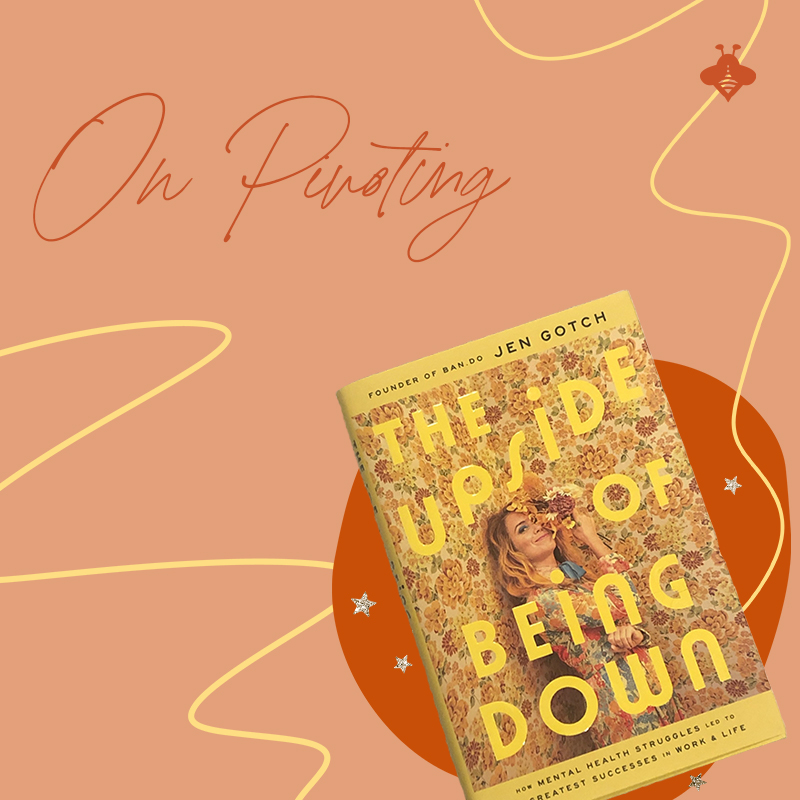On Pivoting: Takeaways from The Upside of Being Down

March 25, 2020

On Pivoting: Takeaways from The Upside of Being Down
Yesterday, a (brave!) Amazon driver finally dropped off my long-anticipated copy of The Upside of Being Down, an autobiography by the co-founder of Ban.do, Jen Gotch.
If you’re unfamiliar with the book, the story details how Jen’s struggles with mental health ultimately led to some of her greatest successes in her life. Not only is the book relatable in terms of transitioning into adulthood and starting a business, but Jen’s true character bounces off the page as she discusses her relationships, emotions, and reactions from her childhood well into her adult life. Her writing makes this one of those treasured books that had me laughing, crying and ruminating about my life, all on the same page.
This book felt timely for a multitude of reasons—I really needed Jen’s humor in this anxious, sheltered time of COVID-19. But what I keep coming back to is her advice to listen to your gut when it says to make a change in your life.
In regards to that, here are a few specific takeaways that I’m safekeeping as a 25-year-old, creative entrepreneur:
1. *Follow signs to pivot*
In the Upside of Being Down, Jen shares how her career took a winding route: first she was a temp, then a waitress, a TV extra, an assistant, a food stylist, and finally, an entrepreneur. This is a common theme in successful life journeys, right? No one figures out what they want to do right away. Some of us are lost in the beginning, which I think many may misinterpret as being unmotivated, but how are you supposed to be motivated if you haven’t found something to be passionate about?
“How are you supposed to be motivated if you haven’t found something to be passionate about ?”
So my takeaway is this: be brave and encourage yourself to try new things. Follow your inner voice when it says it’s curious about something. It doesn’t matter if it’s work-related or a new hobby. Hell, your hobby could become your work. If you don’t have acting experience but have always been intrigued by it, why not try being a TV extra? If you’re interested in food styling, then volunteer your free time to learn. It’s clear that Jen’s spirit isn’t anchored to anything, and I think this is a huge strength for her both professionally and personally. She follows her gut, and that’s how you make pivots and risks work.
Besides, Jen insists that each of her jobs gave her valuable insight that she uses in her role today, whether it’s how do business things or how to not treat her employees (note: don’t refer to someone as “hey you”). Even if a job or hobby feels trivial, you can always pick up insight that will help you find success.
“She follows her gut, and that’s how you make pivots and risks work.”
2. It’s ok to fall out of love with things, including what you do.
One part of finding your definition of success? Knowing when to quit.
Although Jen deep dives into how she fell out of love with her now ex-husband, which is a tear-jerker in itself, what resonated with me on the business side were the times that she fell out of love with her work. I can’t speak for all creatives, but for me it’s always been a challenge to stay “in love” with what I do. I’m only two years into freelancing full-time, and I’ve already begun to take services out of my offerings. Why? Because even though I enjoyed them at one point, my passion for the work is evaporating. And I don’t think it’s fair to my clients to do work that I don’t feel strongly about; I want to keep it meaningful and authentic.
So even though change may be hard, I encourage you to listen to your inner voice and leave when something isn’t serving you anymore. Learn something from Jen—she broke apart from photo styling to start a headband business, which turned into a multi-million dollar brand. If something isn’t fulfilling for you anymore, don’t be afraid to step away from it. That just means there’s something better out there.
“If something isn’t fulfilling for you anymore, don’t be afraid to step away from it.”
3. Making changes usually requires being brave.
So from a birds-eye view, all of this advice seems pretty straightforward. Maybe even easy.
But changing your life is hard.
Throughout the book, I kept thinking, wow, this woman really went through some shit. I mean, she went through some nasty, depressive episodes. Her meds weren’t right for so many years; some exacerbated her symptoms. SHE EVEN THOUGHT SHE WAS GREEN AT ONE POINT, which was both hilariously entertaining and lovingly cringe-worthy at the same time. But despite it all, Jen kept going. She knew that these changes weren’t easy, that therapy wasn’t easy. Starting a business (as all of us know) is far from easy. But she continually got back up when life felt challenging, and I think that’s something to admire. The Upside of Being Down, truly, is that you get a chance to come out stronger than you were before.
Now, before I sign off, I want to note that I don’t know Jen. But based on this book and her IG dance party stories, I think it’s safe to say that she’s a wonderful, positive role model, and I’m looking forward to unpacking more of what I learned from her book. Even though The Upside of Being Down is primarily about mental health, it holds so many lessons about life and running a business; I hope you can learn from her, too!